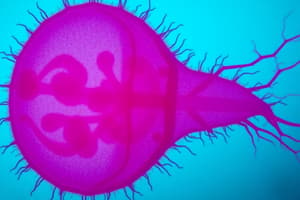Podcast
Questions and Answers
Which organelle is responsible for movement in ciliates?
Which organelle is responsible for movement in ciliates?
- Macronucleus
- Micronuclei
- Cilia (correct)
- Contractile vacuole
Which type of cilia is responsible for feeding in ciliates?
Which type of cilia is responsible for feeding in ciliates?
- Primary cilium
- Membranelles
- Motile cilia (correct)
- Non-motile cilium
What is the function of the cytostome in free-swimming ciliates?
What is the function of the cytostome in free-swimming ciliates?
- Secreting toxins
- Filter feeding
- Movement
- Drawing prey towards the cell (correct)
How do mixotrophic ciliates acquire photoautotrophic ability?
How do mixotrophic ciliates acquire photoautotrophic ability?
What is the main function of the cytoproct in ciliates?
What is the main function of the cytoproct in ciliates?
What are the two types of nucleus found in ciliates?
What are the two types of nucleus found in ciliates?
In which eukaryote supergroup do ciliates belong?
In which eukaryote supergroup do ciliates belong?
Which process involves the swapping of micronuclei and allows for genetic variation in Strombidium and Euplotes ciliates?
Which process involves the swapping of micronuclei and allows for genetic variation in Strombidium and Euplotes ciliates?
Which group of ciliates contains methanogenic endosymbionts and can be visualized under UV light?
Which group of ciliates contains methanogenic endosymbionts and can be visualized under UV light?
Which supergroup do flagellates belong to in all four eukaryote supergroups?
Which supergroup do flagellates belong to in all four eukaryote supergroups?
Which type of flagellates are also known as 'Zooflagellates' and mainly consume pre-formed organic carbon?
Which type of flagellates are also known as 'Zooflagellates' and mainly consume pre-formed organic carbon?
Which group of flagellates possess a collar of tentacles and are more closely related to animals than other protists?
Which group of flagellates possess a collar of tentacles and are more closely related to animals than other protists?
Which type of flagellates have their own plastids and can perform photosynthesis?
Which type of flagellates have their own plastids and can perform photosynthesis?
Which flagellates have an eyespot/stigma organelle that acts as a shading device for photoreception?
Which flagellates have an eyespot/stigma organelle that acts as a shading device for photoreception?
Which mixotrophic flagellate prefers to feed on prey and has few plastids?
Which mixotrophic flagellate prefers to feed on prey and has few plastids?
True or false: Ciliate reproduction involves both asexual and sexual reproduction?
True or false: Ciliate reproduction involves both asexual and sexual reproduction?
True or false: Sulphur ciliates produce methane via methanogenic bacteria?
True or false: Sulphur ciliates produce methane via methanogenic bacteria?
True or false: Flagellates are present in all four eukaryote supergroups?
True or false: Flagellates are present in all four eukaryote supergroups?
True or false: Heterotrophic flagellates are also known as 'Zooflagellates' and mainly consume pre-formed organic carbon?
True or false: Heterotrophic flagellates are also known as 'Zooflagellates' and mainly consume pre-formed organic carbon?
True or false: Mixotrophic flagellates can perform both photosynthesis and ingest prey for feeding?
True or false: Mixotrophic flagellates can perform both photosynthesis and ingest prey for feeding?
Flashcards are hidden until you start studying
Study Notes
Ciliates
- Covered in cilia, most developed protozoan
- Has a cytostome (mouth) and cytoproct (anus)
- Two types of nucleus: macronucleus and micronuclei
- Found in four Eukaryote Supergroups: Excavata, SAR, Archaeplastida, and Unikonta
Structure and Function
- Cilia are microtubule-based hair-like organelles used for movement
- Contractile vacuole and food vacuole present
- Membranelles are stiffer cilia found in cytostome
- Cilia have a 9+2 structure with dynein motor protein in motile cilia
- Non-motile cilia have a 9+0 structure without dynein motor protein
Feeding Mechanisms
- Ciliates use cilia to direct prey towards cytostome
- Membranelles act like a sieve to filter in correct sized prey
- Some ciliates have cirri, which are fused cilia
- Vorticella uses cilia to create a vortex, drawing prey towards the cell
- Suctorian ciliates have microtubule tentacles with cytostome at the end, using extrusomes to dissolve prey contents
Mixotrophic Ciliates
- Acquire photoautotrophic ability through organellar or cellular mixotrophy
- Examples include Strombidium and Euplotes
Reproduction
- Asexual reproduction through transverse binary fission involving mitosis
- Sexual reproduction through conjugation, involving meiosis and mitosis
- Micronuclei are swapped, allowing for genetic variation
Anaerobic Ciliates
- Also known as sulphur ciliates
- Use pyruvate, hydrogenosomes, and methanogenic bacteria to produce H2, acetate, and CO2
Flagellates
- Possess flagellum/flagella with a 9+2 structure
- Used for movement and catching prey
- Found in all four Eukaryote Supergroups
- Examples include heterotrophic, photoautotrophic, and mixotrophic flagellates
Heterotrophic Flagellates
- Also known as zooflagellates
- Most are aerobic, consuming pre-formed organic carbon
- Use flagella for movement and catching prey
- Examples of feeding mechanisms include raptorial feeding and filter feeding
Phototrophic Flagellates
- Also known as phytoflagellates
- Own plastids and photosynthesise
- Examples include Euglena, with an eyespot/stigma for photoreception
Mixotrophic Flagellates
- Can photosynthesise and eat prey
- Examples include Ochromonas, Dinobryon, and Synura
Practical Application
- Studying feeding in mixotrophic Dinobryon divergens
- Effects of light regime and temperature on feeding and photosynthesis
Studying That Suits You
Use AI to generate personalized quizzes and flashcards to suit your learning preferences.




